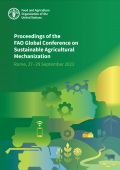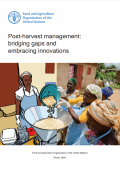Sustainable agricultural mechanization covers all levels of farming and processing technologies, and takes into consideration technological, economic, social, environmental and cultural aspects when contributing to the sustainable development of agrifood systems. This publication strives to comprehensively and systematically summarize the...
Climate-smart agriculture (CSA) is a comprehensive system that requires thorough consideration of local climate, natural environment, market demand, economic and cultural environment. FAO introduced CSA at the Hague Conference on Agricultural, Food Security and Climate Change in 2010 and has...
While the agricultural production in China has made great achievements, it is also facing challenges affecting the sustainable development of agriculture. Conservation agriculture (CA) is a farming system that promotes minimum soil disturbance (i.e., no-tillage and direct seeding), maintenance of...
This five-step guide helps practitioners and project managers improve rural livelihoods by creating or improving business models for sustainable agricultural mechanization for smallholder farmers. The most common business models in rural communities include: mechanization hire services, mechanized value addition of...
The Global Conference on Sustainable Agricultural Mechanization (GAMC) organized by FAO from 27 to 29 September 2023 provided a neutral platform for global stakeholders to discuss sustainable agricultural mechanization for agrifood systems transformation. The conference covered various themes like crop...
This publication contributes to ongoing initiatives aimed at reducing post-harvest loss (PHL) through capacity development and knowledge sharing. It aims to enhance understanding of the gaps in post-harvest management and how to address them. The publication highlights the importance of...
Nepal, a landlocked country known for its mountain peaks including Mount Everest — the world’s tallest peak, is home to Chiti village. Most households of Chiti village rely on agriculture and wage labour for their livelihoods. Rice, maize and wheat...










